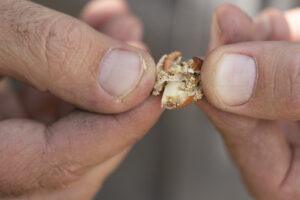Target Tree Nut Pests All Season With an Effective Insecticide Program
Start with good monitoring protocols to plan an effective insecticide program for your tree nuts.

What does it take to plan an effective insecticide program for your tree nuts? Pest management programs should start with good monitoring protocols, knowing how to identify when it’s the right time for treatment.
According to the University of California IPM program, the initiation of hull split is the most effective timing for a single insecticide application. Once you are at 1% hull split and pest flights are present, it’s time to put an effective insecticide program in place to protect your quality and yield potential. Otherwise, these pests can wreak havoc on your tree nuts and even cause fungal infections.
Controlling NOW
Tree nuts are most vulnerable to damage from pests during hull split, as the exposed nut gives navel orangeworm (NOW) and other secondary insects direct access to the nut inside. Larvae bore into the nutmeat and produce large amounts of webbing and frass as they grow. This feeding leads to fungal infections and contamination.
When applied properly and at the right time, a strong pest management plan can help you protect your tree nuts and maximize yield potential from the mummy nut phase through harvest. It’s recommended that you apply a first spray at early hull split and follow-up with a second spray around 10-14 days after.

Defend Against Spider Mites
In addition to NOW, spider mites are also a major problem pest that you should look out for. Mites can damage your foliage by extracting from your trees’ leaves, causing them to turn yellow and fall off. High numbers of mites can also cover tree terminals with webbing. The University of California IPM program found that crop reduction and reduced vegetative tree growth typically shows up the year after damage occurs.
According to the Sacramento Valley Orchard Source, spider mite management can be accomplished through one of two general approaches:
- The threshold and biological control approach helps maintain a balanced ratio of natural enemies-to-spider mites that will allow the beneficials to help suppress spider mite populations by only treating spider mites once economic thresholds are reached, not before.
- An early-season prophylactic approach can be very effective in controlling mites well into summer. However, there could be a downside that may contribute to a later season mite flare up as treatments wear off.
MOST POPULAR ARTICLES
The key to managing and preventing further infestation of damaging pests is to get ahead of them early with a May spray and continue to treat orchards every two to three weeks to maintain control.
Effective Insect Management
With powerful pest management tools, growers and consultants can execute a customized plan to stay ahead of pests throughout the season.
- Minecto® Pro insecticide is a broad-spectrum foliar insecticide that controls navel orangeworm and other damaging secondary pests, including mites in tree nuts. Flexible enough to fit into any management plan, complementary ingredients cyantraniliprole and abamectin combine to form a convenient premix formulation that protects against multiple overlapping pest populations such as mites and navel orangeworm. A May spray application of Minecto Pro is important if there are remaining mummies on the trees from the prior season and the time to consider a proactive spray for mites.
- Besiege® insecticide provides dual-action protection against the most difficult lepidopteran pests, including navel orangeworm, peach twig borer, codling moth, leaffooted plant bug and walnut husk fly. With long-lasting residual and outstanding knockdown, Besiege is ideal for application at hull split.
Building an insecticide program with a combination of these products can help you manage insects in your orchards this season.
3 Min Read























